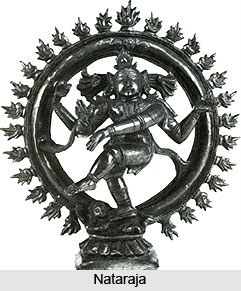 Nataraja is the divine manifestation of Lord Shiva, assumed as the Lord of Dance especially Bharatanatyam. The popular image of Shiva can be seen in the several bronze sculptures of as early as the eleventh century. Still reckoned as the "finest expression of rhythmic movement` the sculpture Nataraja awes while captivating the beholder.
Nataraja is the divine manifestation of Lord Shiva, assumed as the Lord of Dance especially Bharatanatyam. The popular image of Shiva can be seen in the several bronze sculptures of as early as the eleventh century. Still reckoned as the "finest expression of rhythmic movement` the sculpture Nataraja awes while captivating the beholder.
There is a legend behind this Nataraja form of Shiva. It is said that once Shiva, accompanied by Vishnu disguised as a beautiful woman. They set out to discipline ten thousand unorthodox holy men who were living in a nearby forest. These holy men became angry and evoked a fierce tiger out of a sacrificial fire and sent it against Shiva to kill him. But Shiva simply condemned it and wore its skin as a shawl. Then, he was attacked by a poisonous snake but Shiva tamed it too and hung it round his neck like a garland.
Afterwards, the holy men sent a fierce black dwarf to kill Shiva with a club. But, to their dismay, Shiva put one foot of him on his back and performed a magical dance, which was so dazzling that, the dwarf and then the holy men could realise Shiva as their master. The symbolism of this dance was interpreted in different ways. This particular dancing form of Shiva was then onwards called Nataraja.
This Shiva Nataraja form represent Lord Shiva as the moving force of the universe and his five supernatural acts of creation, preservation, destruction, embodiment, and release of the souls of men from illusion. The last but not the least purpose might be linked to the idea that release can be found in the fire of the cremation ground, perhaps here symbolised by the ring of flames round the dancer.
It is interpreted that in this dance form, Lord Shiva`s body resembles the sky; while his hands entreat the eight direction and his three eyes stands as the manifestation of sun, moon and the eight directions. His smile acts as the distraction of evil, his hair embodies wisdom. Enlightenment is shown amidst the glaze of his crescent moon while his sacred thread stands as the logo of Indian philosophy. His garments are the Vedas and the damaru that he holds stands for the first creation of sound. His Abhayam mudra signifies protection and His varada is for liberation .The tiger skin that he wraps act to control anger; His anklets direct to a good path, the serpent around his neck controls jealousy and the deer signifies compassion. The body of dwarf apasmara-purusha stands as the embodiment of indifference, laziness and ignorance.
The Nataraja figure of Shiva was caught in mid-dance with one foot on the demon and the other poised for the next step. The long matted hair fans out on both sides of his head. A sash tied round his waist also streams out with the frenzied movement. The circle of stylized flame confines his vitality and energy. The drum in his hand represents the five rhythms of manifestation. The cosmic dancer embodies the rhythm of the universe.












